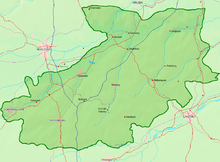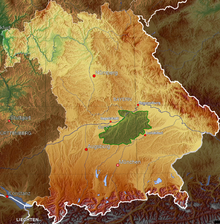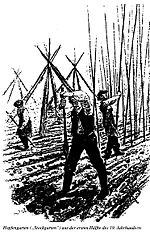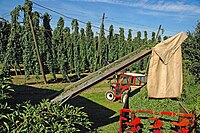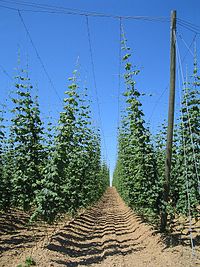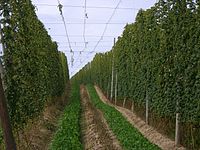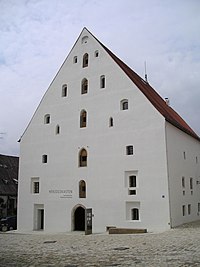Hallertau
The Hallertau (also Holledau or Hollerdau ) is a cultural landscape in the middle of Bavaria . With 2,400 km² it is the largest contiguous hop growing area in the world. Around 86% of the German and around 34% of the hops processed worldwide are produced here (as of 2016).
Geography and geology
The Hallertau extends over the Bavarian administrative districts of Upper and Lower Bavaria to parts of the districts of Pfaffenhofen , Freising , Kelheim , Landshut , Eichstätt and Neuburg-Schrobenhausen .
Since the region is not an administrative unit , but is only defined by the common hop cultivation, an exact delimitation is not possible. The cities of Ingolstadt , Kelheim , Landshut , Moosburg , Freising and Schrobenhausen form a rough framework . From an administrative point of view, it corresponds most closely to the Altlandkreis Mainburg . The total area of the Hallertau is around 2,400 km², it extends a maximum of 65 km in east-west direction and is up to 50 km wide in north-south direction.
The southern boundary of the Hallertau corresponds roughly to the course of Glonn , Amper and Isar , the northern boundary is roughly the Danube , but since the incorporation of the Altmannstein district, Hallertau hops have also been grown north of the Danube . The right tributaries of the Danube, Paar , Ilm , Abens and Große Laber as well as the Kleine Laber flow through the area.
According to the official topographic map, the highest elevations in the Hallertau are at 534 m above sea level. NHN northwest of Osseltshausen , at 533 m above sea level. NHN in Schweitenkirchen and at 531 m above sea level. NHN north of Winden (west of Schweitenkirchen).
In terms of natural space, the Hallertau largely belongs to the Danube-Isar hill country , which geologically belongs to the Tertiary hill country and was not covered with ice during the Pleistocene . The topmost deposits, which lie under the crust, are freshwater deposits from the Miocene .
Name declarations

The original meaning of the name, which has been in use since the 14th century, is not entirely clear. The most likely combination of the Old High German words "Hardt" (= forest) and "hall", derived from "helan" (= to hide, to heal), to "Hal hart", a forest that hides its interior, a wild one Primeval forest to which the field name “Au” was added. Johannes Aventinus leads in the early 16th century, the situation of the source of the river Abens of: ". Springs ... At midnight bey a dorff haißt Haller unnd Hollerthaw" Two kilometers south of Abensquelle, between the villages of Holzhausen and Hirschbach southeast of Schweitenkirchen , is a located three kilometers long mixed forest, which is still called "Holledau" today. Philipp Apian gives the following declaration on this piece of forest in his country tables from 1566 under the keyword Hirschbach: “… the forest that extends from there east to north is called Hallerthaw. Almost the entire region up to the Ilm receives the same name; it is completely full of hills and forests. "
The official spelling dates from 1926, when the name of the village of Au was changed from "Au bei Freising" to "Au in der Hallertau".
The orally handed down story that a prince, when he got into distress in the battle of Gammelsdorf (1313), sent for help with the words "Hol 'Er d' Auer", from which the name derives, belongs more to the realm of legend Hallertau is said to have developed for the region around Au .
Hop growing
history
The hop-growing in the region since the 8th century occupied. The places Geisenfeld and Gründl near Nandlstadt both claim to be the area of origin of the cultivation. In the year 736, prisoners of war Wends - a Slavic tribe - are said to have laid out the first Hallertau hop garden on Geisenfeld soil. Until the beginning of the 19th century, the region around Spalt near Nuremberg was the main growing area in the region. Only after the peasants were liberated in 1848 were the requirements for an increase in production in the Hallertau met; the yield rose from 1,500 quintals in 1815 to over 75,000 quintals in 1865. The Hallertau has been the largest cultivation area in Germany since 1912.
rationalization
To make the harvest durable, the cones were piled up on so-called “hordes”, also known as “Reuter”, to dry in the air. At the end of the 19th century, the Wolnzach carpenter Max Eder developed a two-story kiln . The furnace, fired at the bottom, heated a heating pipe spiral which dried the cones above.
Until the beginning of the 20th century, every single vine grew up on a wooden pole as a climbing aid. Shortly before the First World War, the hop gardens were converted to wire frame systems, which was completed around 1930 in the Hallertau.
In order to separate the cones from the vines, up to 200,000 so-called "hop plucks" came from the structurally weak areas of the Upper Palatinate , the Bavarian Forest and the Donaumoos around Ingolstadt to the Hallertau at peak times . When the labor force became scarce during the period of economic growth, mechanical picking machines were introduced in the 1950s. The first machine was imported from England in 1955, later the Wolf company built picking machines in Geisenfeld . The hops have been harvested completely by machine since 1967 .
Today, hops are grown almost exclusively by family businesses. A few helpers, mostly from Eastern Europe, are only employed in the growth phase for cutting and “guiding” and during the harvest.
development
The hop growing area extends 37% over the district of Pfaffenhofen , 37% over the district Kelheim , 13% over the district Freising and 8% over the district Landshut (as of September 2004) . These four districts came together in 2005 to promote tourism in Hallertau to form the “Hopfenland Hallertau” working group. 4% of the acreage is in the Eichstätt district , 0.3% in the Neuburg-Schrobenhausen district and 0.7% in the city of Hersbruck .
The number of growers has been falling sharply since the beginning of the 1990s due to the lower average price for hops and the resulting lower profitability of hops growing as a sideline. The cultivated hops area in the region also fell by around 4,000 hectares during this period. Two thirds of the hops harvested are exported.
With 14,200 hectares , which are cultivated by 1,251 growers (as of September 2006) , Hallertau, which is divided into 14 districts with a seal , is the largest contiguous hop-growing area in the world. Approx. 85.4% of the German hops are produced here, the share of the world market is around 31.5% (as of 2005) .
Development of the number of growing operations and areas in the Hallertau:
| year | Establishments | Surfaces |
|---|---|---|
| 1950 | ~ 15,000 | ~ 7,000 |
| 1960 | 7,818 | ~ 8,000 |
| 1996 | 2,270 | ~ 17,800 |
| 1999 | 1,930 | 14,652 |
| 2001 | 1,630 | 15,510 |
| 2006 | 1,251 | 14,221 |
| 2009 | 1,197 | 15,485 |
| 2016 | 931 | 15,510 |
Sealed districts
To ensure the quality of the hops, the hop bales are sealed and certified. The first sealing and weighing station was built in Wolnzach in 1834.
|
Pfaffenhofen an der Ilm district |
District of Kelheim |
|
District of Freising |
Landshut district |
The Altmannstein growing area in the Eichstätt district was incorporated into the Hallertau in 1992.
Hersbruck in the Nürnberger Land has been counted as the 15th seal district since 2004; geographically, however, it is not in the Holledau.
Asparagus cultivation
In addition to the hops, which are produced in practically all of Hallertau, the cultivation of asparagus is also of great importance in some regions . The most important growing areas are around Abensberg , Schrobenhausen and Pörnbach .
Culture and sights
Buildings
A large number of sights can be found in the Hallertau area. One of the highlights is probably the Scheyern Monastery , which emerged from the former ancestral castle of the Counts of Scheyern . The landmark of Pfaffenhofen an der Ilm is the parish church , whose 77.7 meter high, tapering tower towers over the townscape. The imposing former collegiate church of St. Arsatius von Ilmmünster stands on a hill south of the district town .
The moated castle Reichertshausen is located in a spacious English park . The Rohrbach Castle, together with the historic fortified church and the old tavern, form an ensemble that is well worth seeing. The modern basilica of the Transfiguration of Christ on the mountain, designed by the architect von Branca, dominates on a hill above the town . The pilgrimage churches of Sankt Kastl and Lohimmern , jewels of the Gothic and Baroque styles , are each two kilometers away from Rohrbach . A structural specialty is the town parish church (former monastery church ) of Geisenfeld , whose south tower was doubled in the Renaissance style.
The old town of Abensberg is almost intact. In 2006 the new city museum was opened in the Duke's Box , which until then had been called the Aventinus Museum and was located above the cloister of the Carmelite monastery . The Kuchlbauer Tower , which opened in 2010 and was designed by Friedensreich Hundertwasser , is located on the edge of Abensberg's old town . The Baroque pilgrimage church of the Assumption of Mary is located in the Allersdorf district . The remains of the Abusina , a former Roman fortification, can be found near the Neustadt district of Eining . In the far north of the Hallertau is the Benedictine Abbey of Weltenburg Abbey with the Asam Church at the Danube breakthrough. The Rohr monastery is also located in the Kelheim district , also with an Asam church. The landmark of Mainburg is the Salvator Church of St. Peter and Paul of the Pauline monastery on the Salvatorberg.
In Nandlstadt in the Freising district, the town hall from 1881 has a neo-Gothic pinnacle tower. In Hörgertshausen , next to the parish church of Jakobus the Elder, there is the pilgrimage church of Sankt Alban . In Au in der Hallertau there is the castle brewery next to the water castle of the Beck von Peccoz family .
The Romanesque appearance of three churches remained almost unchanged: St. Ulrich in Ainau, St. Petrus in Griesbach and the tower church in Gasseltshausen near Aiglsbach.
Museums
- The German Hop Museum in the Wolnzach center of the Hallertau was opened in 2002. In addition to the regional history of hops, the exhibitions also deal with developments in other German growing areas.
- The Museum of Cultural History of the Hand is also located in Wolnzach . Since 1996, the exhibition has shown exhibits on the subjects of anatomy, gestures and symbolism.
- The only hop museum in Lower Bavaria is located in the Mainburg City Museum. In the museum founded in 1912, a section is dedicated to the history of the cultivation of the green gold of the Hallertau. Devices, tools and machines tell of the efforts, inventions and skills in hop growing from days gone by, and the effort that the hop farmers involved in growing and harvesting hops prior to the technicalization.
- In the Hallertau Hop and Local History Museum in Geisenfeld and in the Hörgertshausen Local History Museum , an overview of the history of local hop cultivation is given and religious folk art and agricultural implements are shown.
- The Abensberg City Museum in the Herzogskasten shows the development of the city in economic, social, cultural and religious terms and describes the life of various important sons of the city, above all that of the Bavarian historian Johannes Aventinus .
- In Pfaffenhofen, a poetry museum is dedicated to the writer Joseph Maria Lutz in the gate tower on the “Platzl” . On the main square, the Lebzelterei- u. Wax pulling museum of past professions.
- The museum in the Mesnerhaus in Pfaffenhofen a. d. Ilm holds a rich collection of religious objects from churches and town houses, such as figures of saints, monastery work, Fatschenkindl, votive offerings or death boards. On the ground floor the visitor will find an outline of the history of the district town of Pfaffenhofen. A museum depot is attached to the museum in the Mesnerhaus in Pfaffenhofen. It is located in the district of Heißmanning in the Thalmeier-Hof. There the district and the city of Pfaffenhofen have put together an extensive collection of old equipment and vehicles from agriculture and handicrafts, e.g. B. a shoemaker's workshop, blacksmith's shop, rope-making, hat-making.
- Probably the only Roman spa and bathing facility in Bavaria can be viewed under the secularized St. Andreas Church in Bad Gögging .
regional customs
Costume
The Holledauer costume is first described by the State Directorate Joseph von Hazzi around 1800 . The men's robe consisted of black linen or wool trousers with blue stockings. In addition, a red vest and a black or blue long skirt (coat) were worn. In addition to large silver buttons, the so-called pleated boots (accordion bellows) were a feature of the costume. Women had padded skirts and a tight bodice, over which a short jacket. Married women wore otter hats, unmarried blue cloth hoods.
music
The title of the Hallertau song is "Mia san Holledauer". Music historians date it to around 1790. A second song is the so-called “Holledauer Schimmellied” from around 1750. Another very well-known song in the Hallertau is the “Holledauer Liad”. In 5, sometimes 6 stanzas, love of home, faith and culture are sung about in a humorous way. In the 6th verse, which is not always or not always sung, the author of the song is sung about and praised. In 1920 Erhard Kutschenreuter composed the Singspiel Der Holledauer Fidel .
The group "Dellnhauser Musikanten", which has existed since 1948 and played at the Munich Oktoberfest , among other places , is well known.
Events
Markets and festivals
Traditionally, almost every city, every market and every municipality holds a folk festival. However, three markets have a centuries-old tradition:
- The Gillamoos in Abensberg is called "the festival of the Hallertau" and is one of the oldest markets in Bavaria. The five-day market with pithy speeches by prominent German politicians takes place on the weekend around the first Sunday in September.
- The four-day Gallimarkt in Mainburg takes place on the second weekend in October. The market law was Mainburg in 1397 by the Duke of Bavaria-Munich awarded.
- The Albigan market in Sankt Alban was the most important pilgrimage in the Hallertau with its staff and animal market on the 5th Sunday after Easter and the following day, which dates back to the 12th century and is still taking place today.
A special feature is the Hellring , a Dult in the municipality of Langquaid. During a pilgrimage at the beginning of October, the local farms have a rare bar license for five days.
Gastronomic weeks
All over the Holledau, many restaurants take part in campaign weeks for seasonal products:
- Hallertau hops asparagus weeks : mid-March to the end of April - the young, still white shoots of the hops are considered a delicacy;
- Hallertau Asparagus Weeks : end of April to June 24th;
- Hallertau Hop Weeks : beginning of August to mid-September;
- Hallertau Wildlife Weeks : mid-October to mid-November.
Personalities
The chronicler and pioneer of classical philology Johannes Aventinus was born in Abensberg ; likewise the reformer Stephan Agricola . The dean of the medical chair of the University of Ingolstadt and personal physician of Maximilian III. Joseph of Bavaria Prof. Dr. Philipp Fischer was born in Hörgertshausen in 1744 . The Rococo painter Christoph Thomas Scheffler comes from Mainburg , the most important Rococo sculptor, Ignaz Günther , was born in Altmannstein.
The writer Joseph Maria Lutz is a son of the city of Pfaffenhofen, as is the writer Steffen Kopetzky . The painter and entrepreneur Claus Hipp runs the Hipp company and lives near Pfaffenhofen. The German and linguist Johann Andreas Schmeller spent his childhood and youth in Rinnberg near Rohrbach.
The folk singer Roider Jackl was born in Weihmichl and worked in the Freising Forestry Office until his retirement. The folk actor Josef Thalmaier was born in the Rohrbach district of Fahlenbach . The composer Erhard Kutschenreuter worked in Rudelzhausen , where he was inspired to write his most famous piece, the Holldedauer Fidel .
Others
The motorway triangle between the A 9 and the A 93 bears the name Holledau after the region , as does the motorway service station two kilometers to the south . The Holledau service station was the first to open in Bavaria in 1938 and is one of the three oldest in Germany.
On June 23, 2006, the German Hop Road along the B 301 officially got its name (unofficially, the name had been in use for a long time). The Bavarian Beer Route also leads from Ingolstadt to Kelheim through the Hallertau.
The Hallertau Local Railway ran from Rohrbach via Wolnzach to Mainburg through the Hallertau. A branch line to Langenbach went from this in Enzelhausen . A railway line to Geisenfeld also ran from Rohrbach . There was a railway from Landshut to Rottenburg . With the exception of short parts for freight traffic on the Hallertau Local Railway, these routes have been closed and most of them dismantled. Behind the end of the track at the Wolnzach district of Jebertshausen begins a cycle path, which mostly follows the former route through the Hallertau.
literature
- Emmi Böck (texts), Helmut Münch (photos): The Hallertau . Pinsker-Verlag, Mainburg 1973, ISBN 3-920746-10-4 .
- Anton Graf: The Hallertau and its hop growing: an ethnographic and economic study . Munich 1975. (Dissertation).
- Lorenz Kettner: The development of the Hallertau into the largest hop growing area in the world in the 19th and century . BLV-Verlagsgesellschaft, Munich 1975.
- Lorenz Kettner: Hallertau hop growing . Pinsker-Verlag, Mainburg 1976.
- Günther Knoll (texts), Hannes Sieber (photographs): The Hallertau . Frisinga Verlag, Freising 1986, ISBN 3-88841-013-4 .
- Dieter Vogel (Ed.): The Hallertau. Homeland book . Verlag Kiebitz-Buch, Vilsbiburg 1998, ISBN 3-9804048-4-6 .
- Peter M. Busler: The Hallertau: Portrait of an urban Bavarian landscape . Pfaffenhofen 1990, ISBN 3-7787-3365-6 .
- Adolf Widmann: Mia san Holledauer. Hallertau compatriots, their home and their life . Galli, Kartographischer Verlag, Hohenwart 2001, ISBN 3-931944-58-1 .
- Christoph Pinzl: The hop region. Hop growing in the Hallertau - a cultural history . German Hop Museum Wolnzach, Wolnzach 2002, ISBN 3-929749-02-5 .
- Reinhold Lang (ed.): The Hallertau reading book. Pictures and stories from the Hallertau . Pinsker-Verlag, Mainburg 2004, ISBN 3-936990-11-5 .
- Franz X. Bogner: The Hallertau from the air . Bayerland-Verlag, Dachau 2013, ISBN 978-3-89251-439-8 .
- Eduard Albrecht: biography of Simon Wittmann. The rise of an apprentice tailor to economist , Heimatkundliches Blatt 2016-2 of the city of Neustadt adDonau
Television documentaries
- 2003 - Back then ... Hop harvest in the Hallertau , BR -Documentation by Sybille Krafft
- 2009 - La Vita: Die Holledau , BR and 3sat
See also
- German Hop Museum
- Hallertau hops and local history museum
- Hallertau hop queen
- Hop Research Center Hüll
Web links
Individual evidence
- ↑ Final report for the hops of the 2016 harvest, which are subject to the official designation. Hopfen-Rundschau, November 18, 2016, accessed on September 6, 2017 .
- ↑ IHGC - Economic Commission summary reports. International Hop Growers' Convention, November 7, 2016, accessed September 6, 2017 .
- ↑ [1] official topographic map
- ↑ [2] official topographic map
- ↑ [3] official topographic map
- ^ Theodor Wiedemann (ed.): Johann Turmair, called Aventinus, historian of the Bavarian people . Datterer, Freising 1858, p. 5 ( Johann Turmair, called Aventinus, historian of the Bavarian people ).
- ↑ a b Peter M. Busler: The Hallertau. Portrait of an urban Bavarian landscape. Ludwig Verlag, 2001, ISBN 978-3-7787-3365-3 , p. 9.
- ↑ Peter M. Busler, p. 29
- ↑ hvg-germany.de: Hallertau growing area
- ↑ Annual report of the Bavarian State Office for Agriculture ( Memento from September 6, 2006 in the Internet Archive ) p. 23 (PDF file; 1.53 MB)
- ↑ stadtmuseum-mainburg.de: Oh wonderful drudgery
- ^ Museum in the Mesnerhaus in Pfaffenhofen. (No longer available online.) In: Website Landkreis Pfaffenhofen. Archived from the original on October 20, 2013 ; Retrieved August 6, 2013 . Info: The archive link was inserted automatically and has not yet been checked. Please check the original and archive link according to the instructions and then remove this notice.
- ^ Museum Depot Heissmanning. (No longer available online.) In: Website Landkreis Pfaffenhofen. Archived from the original on October 20, 2013 ; Retrieved August 6, 2013 . Info: The archive link was inserted automatically and has not yet been checked. Please check the original and archive link according to the instructions and then remove this notice.
- ↑ Augsburger Abendzeitung (ed.): The collector . Augsburg 1873. p. 212
Coordinates: 48 ° 38 ' N , 11 ° 46' E
